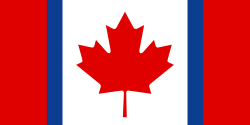| This article relies excessively on references to primary sources. Please improve this article by adding secondary or tertiary sources. Find sources: "Canadian Duality Flag" – news · newspapers · books · scholar · JSTOR (April 2013) (Learn how and when to remove this message) |

The Canadian Duality Flag (French: Drapeau de la dualité canadienne; also called the Canadian Unity Flag) is an unofficial flag that was originally circulated to demonstrate the unity of Canada during the lead-up to the 1995 Quebec referendum, at rallies for the "no" side. The Duality Flag design was chosen to represent explicitly the Francophone and Anglophone populations on the national flag by adding blue stripes to the red sections, roughly in proportion to the number of Canadians who are primarily French-speaking. The blue was chosen as it is the main colour that is used on the flag of Quebec.
See also
References
- "Other Canadian flags (Canada)". CRW Flags. Retrieved 2008-04-13.
- "Canadian Duality Flag". Canadian Duality. Retrieved 2008-04-13.
This Canadian flag-related article is a stub. You can help Misplaced Pages by expanding it. |
This article about culture in Canada is a stub. You can help Misplaced Pages by expanding it. |